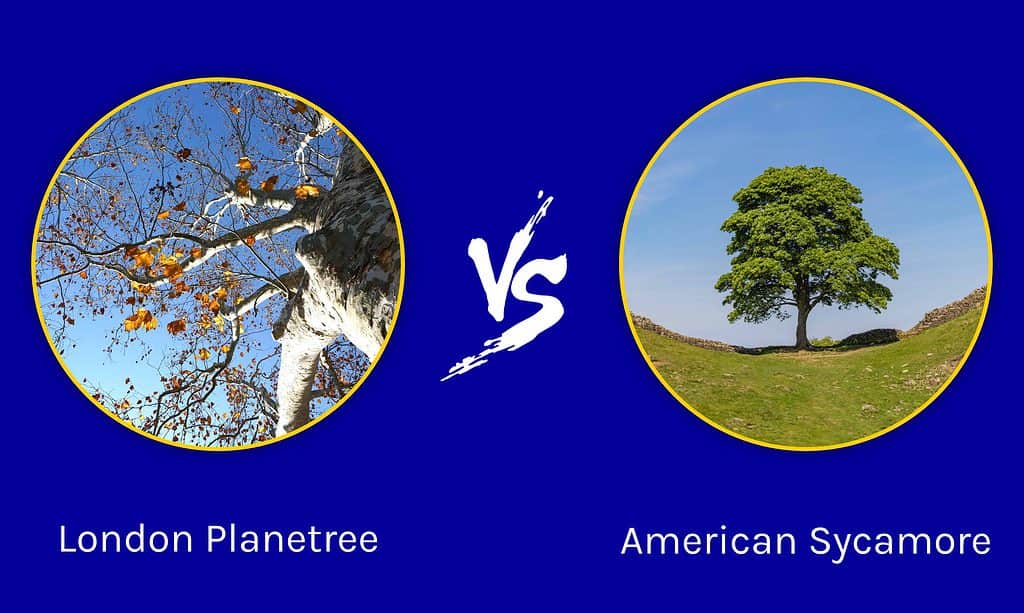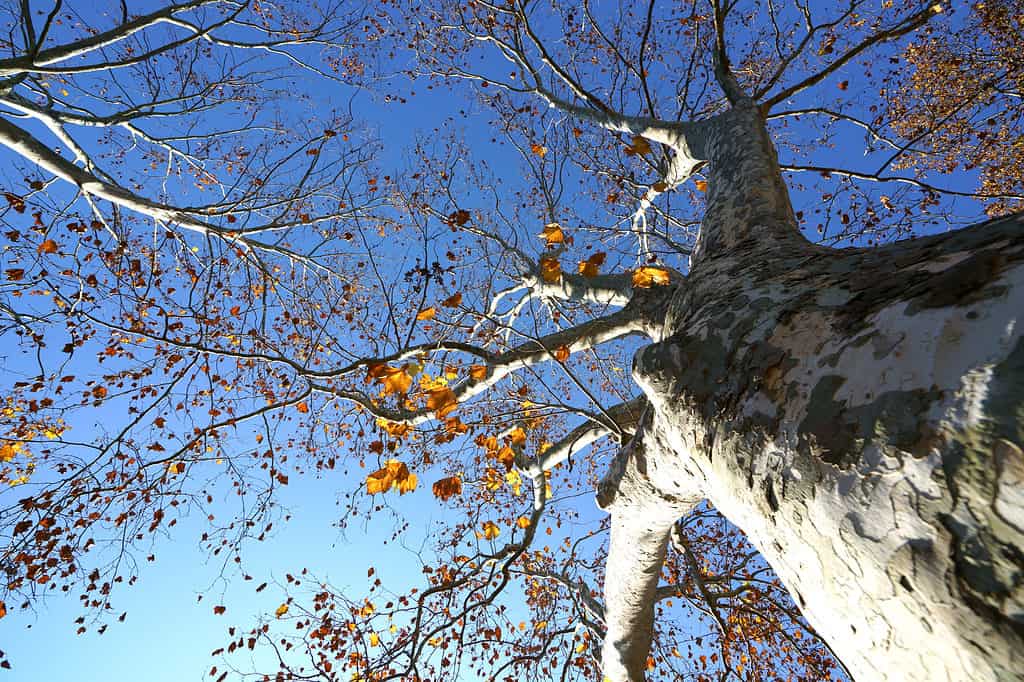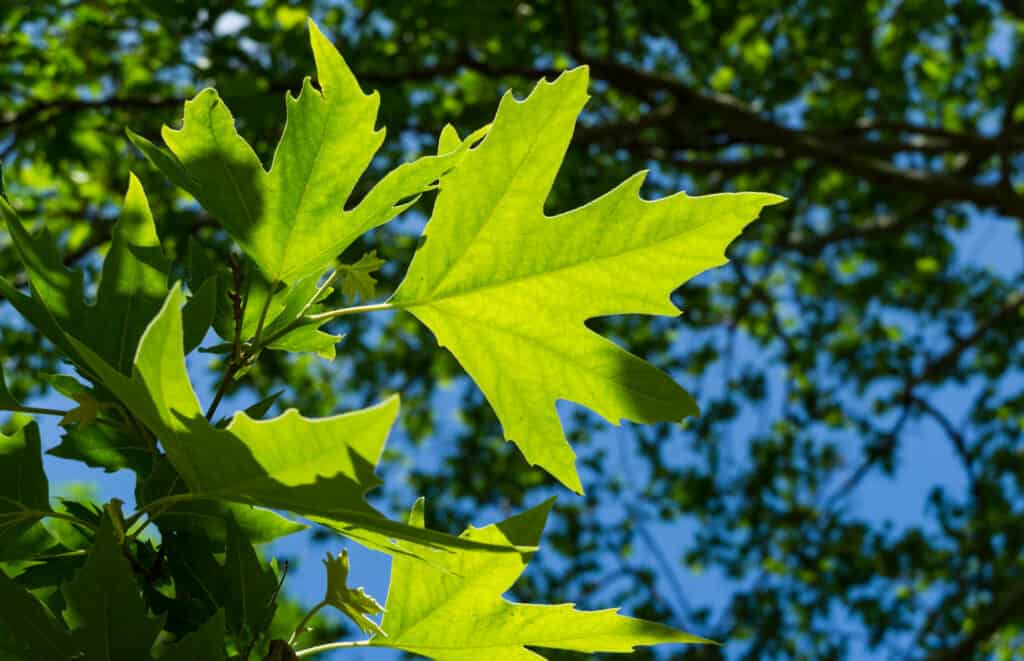The London plane and American sycamore trees are similar in appearance, so it’s easy to confuse them when they pop up together. They both have the same shape of leaves and a generally upright form. However, mature trees can be easily distinguished by looking at their bark and seeds. The bark on a London planetree is mottled with areas of greenish-gray that look like patches or plates, while the American sycamore has scaly grayish-brown bark that looks almost shaggy.
In terms of seeds, the London plane has two slightly fuzzy brown clusters in each seedpod, while the American sycamore only has one fuzzy brown cluster per pod. London planes are common in landscaping due to their beautiful appearance and tolerance for pollution, although some escape cultivation into wild areas where they become established over time. American sycamores thrive naturally in riparian zones but may also be used for landscaping purposes as well. Both species provide spectacular beauty wherever they appear! Let’s have a look at the differences below.
Comparing London Plane vs. Sycamore

The London planetree, also known as Platanus x acerifolia, is a hybrid species of the North American sycamore tree. It has distinct characteristics that make it easily distinguishable from the closely related American sycamore (Platanus occidentalis). One way to differentiate between these two trees is by looking at their bark. Another characteristic that helps tell them apart is the number of fruit clusters each produces. Let us explain that more fully below!
| London Planetree | American Sycamore |
|---|---|
| Mottled bark starts at the base of the trunk. The bark is thinner and lighter in color. | Mottled bark starts midway up the tree trunk. The bark is thicker and has a darker color. |
| The inner layer of the bark is yellow and olive green. | The inner layer of bark is white, cream, and gray. |
| Produces two or three fuzzy seedheads in a cluster. | Produces one fuzzy seedhead per stalk |
| Pronounced lobes on the leaves. | Leaves are lobed but sometimes less so. |
| The leaf is longer than it is wide. | The leaf is wider than it is long. |
| They are more likely to be growing in a big city. | More likely to be growing near a stream or low wetland in the Eastern U.S. |
Key Differences
The key differences between the American sycamore and London planetree are the mottled bark and the number of seed heads or fruits produced.
American sycamore is native to riparian areas and floodplains, with distinctive mottled bark, especially midway up on the trunk and upper branches. It produces only one seedhead on each stalk.
London planetree also has mottling on its bark, revealing the underlayers, which usually go all the way to the bottom of the trunk, even on older trees. It produces seedheads in clusters of two or three on the same stalk.
London Plane vs. Sycamore: Bark

The bark of London planetrees has a distinctive peeling pattern.
©High Mountain/Shutterstock.com
The American sycamore, which is one of the largest hardwood trees in North America, can reach heights of up to 140 ft tall. This species has light brown bark that peels away from the trunk in a pattern known as exfoliation. The exposed inner layers are sometimes white, cream, or gray in color and give these trees an eye-catching appearance. Additionally, many individuals will find that sycamores have distinctive mottled trunks with patches of lighter-colored wood covering the darker bark beneath them.
The bark of London planetrees is almost unmistakable, with its distinctive peeling pattern revealing a pale yellow inner layer. The outer layer of the tree’s bark is comprised of grayish-brown sheets that peel off in flakes or strips to reveal a creamy-yellow hue beneath. This unique style of bark provides an interesting aesthetic contrast and gardeners and tree enthusiasts alike can easily identify it.
London Plane vs. Sycamore: Leaves

Sycamore leaves can grow to a length between four and seven inches.
©iStock.com/Marina Denisenko
The leaves of the sycamore tree are simple and alternate, growing to a length of 4-7 inches. The light green color is broken up by 3-5 lobes that have coarse teeth on their margins. Young leaves are covered with tufts of white woolly hair on the undersurface.
In contrast, London planetree leaves grow 6 to 7 inches wide and have three to five lobes like maple trees. While they have untoothed or nearly untoothed margins, they have leathery, bright green leaves which pale slightly underneath. Fall brings yellow-brown coloring to the foliage as it transitions into winter dormancy.
London Plane vs. Sycamore: Fruit
American sycamore tree fruit is a unique type of aggregate fruit that consists of many small seed-like fruits called achenes, which are attached together in a burr-like ball, one per stem. These balls can be quite light and may even float on water, making it an effective way for the seeds to disperse.
The London Planetree produces similar spherical seed balls filled with tightly packed capsules. The fruit ripens to a dark brown color in October and remains on the tree until winter hits. Dried London planetree fruits come grouped together in clusters of 2 to 3 seed balls. When winter arrives, the wind will break them apart so their seeds can spread further away from the parent tree.
London Plane vs. Sycamore: Growth Requirements

Hardy as they are, sycamores can tolerate many soil types.
©iStock.com/dapec
Sycamores are hardy trees that can thrive in full sun and tolerate all kinds of soil types. They prefer moist conditions but will survive with only occasional watering during dry periods. Fertilizing at planting and once during the spring is recommended for best growth. Pruning is usually unnecessary since these trees tend to be self-maintaining.
The London planetree also has a wide range of adaptability when it comes to growing conditions but does particularly well in deep, rich soil with good drainage, such as loam, sand, or clay soil types. It has no problem dealing with acidic or alkaline pH levels and even some compaction from foot traffic or heavy machinery.
The photo featured at the top of this post is ©
Sources
- Buckeye Yard and Garden Online / Accessed January 19, 2023
- BPlant.org / Accessed January 19, 2023
- NC State University Extension Gardener / Accessed January 19, 2023
- University of Redlands / Accessed January 19, 2023
Thank you for reading! Have some feedback for us? Contact the AZ Animals editorial team.







